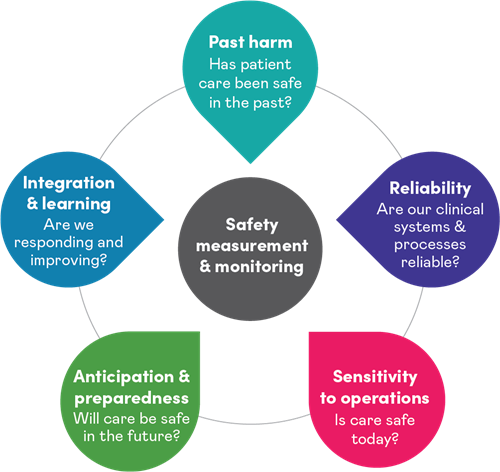Safety is fundamental to excellent healthcare. We all expect, and deserve, safe care.
While patient safety is and has long been a recognized priority by passionate healthcare leaders, front-line staff, patients and caregivers, there remain many opportunities to improve safety outcomes to eliminate known sources of harm. For example, the Canadian Institute for Health Information (CIHI) estimates that across the country, one in 17 hospital stays involved at least one harmful event [1]. And unintended harm is experienced outside of acute care settings as well. According to the Safety at Home: A Pan- Canadian Home Care Study released in 2013, for instance, 10-13% of home care clients experience adverse events each year. The study found that half were preventable.
Data like these are important in telling us what has happened in the past – reporting, tracking, and measuring incidents of harm in the past. Measuring quality and safety helps to identify opportunities for improvement, track progress, and ultimately strengthen patient care and outcomes.
But the absence of harm in the past is not the same as the presence of safety now or in the future. Think about it this way – just because a young child was unharmed in dashing across the street yesterday does not mean that the outcome will be equally happy today or tomorrow.
Tackling the culture of safety: the Measurement and Monitoring of Safety Framework

The Measuring and Monitoring Safety Framework
Professor Charles Vincent and colleagues took this perspective in their 2013 Measuring and Monitoring Safety Framework (MMSF). Their work motivated a transformation in the way patient safety is both defined and practiced. It represents an important shift from focusing on the absence of harm to adopting a broader view of safety that examines sources of resilience and capabilities that enable safe care, as well as endorsing a proactive approach to improving safety.
We’ve seen this work in practice. In 2017, the Canadian Patient Safety Institute (CPSI)* began working with healthcare teams from across Canada to advance knowledge and experience of the MMSF in Canada. Teams from across the country worked locally, with each other, and in collaboration with CPSI and Dr. Ross Baker at the University of Toronto and others to develop a more comprehensive approach to safety through implementation of the MMSF. A recent evaluation found that this approach grew teams’ knowledge about the Framework and supported them to implement the approach locally. Most participants perceived this work to have positive impacts on stakeholders’ knowledge and behaviours, as well as on healthcare processes and patient outcomes.
Together, through the eyes of patients and their care partners
In 2019, a research project was launched to assess how this proactive approach to safety resonates with patients and care partners. Steered by an advisory group co-chaired by Dr. Ross Baker and Maaike Asselbergs, the work has woven together rich perspectives developed through lived experience. How Safe is Your Care? Measurement and monitoring of safety through the eyes of patients and their care partners summarizes patients’ and care partners’ perspectives on safety and on their effective engagement in all aspects of measurement and monitoring of safety. It also offers recommendations on how to strengthen provider and patient partnerships for the purpose of delivering safer care.
Safer care depends on everyone, and there is much more we can and must do. Together. We hope you will join with us to truly move from a culture of blaming, shaming, and fear to one that embraces the presence of safety. Proactively and in a sustained and sustainable way.
In addition to the resources linked above, many tools and resources are available on our website to support this journey. Examples include open access learning for improving team functioning, resources to support safe re-integration of essential care partners into health and care settings, on-demand virtual learning, and much more.
To be notified of upcoming opportunities for learning and exchange, as well as new resources, please sign up for HEC’s newsletter.
To contact a member of HEC’s safety team, please email safety-securite@hec-esc.ca.
* In 2021, the Canadian Patient Safety Institute (CPSI) and Canadian Foundation for Healthcare Improvement (CFHI) came together to form a new organization, Healthcare Excellence Canada (HEC)
[1] Patient harm in Canadian hospitals? It does happen. | CIHI
